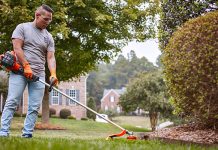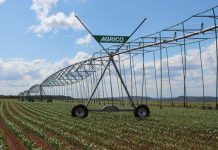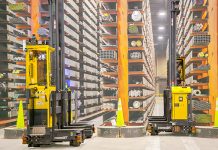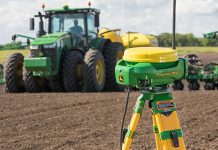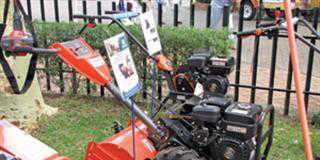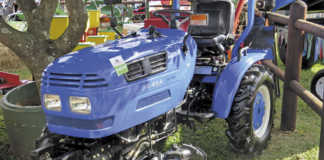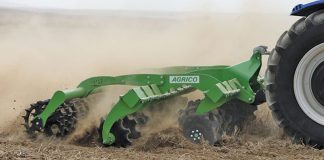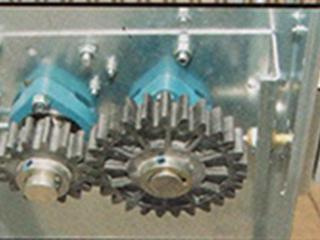
Big Dutchman International’s automatic dung belt system for layer operations
A dung belt in a commercial layer house, if loaded unevenly, will tend to run inconsistently, rub against the guides and ultimately tear. To counter this, it is necessary to regularly correct the belt’s pre-tension system by hand. In the modern commercial layer house, however, this is a laborious and time-consuming task. Big Dutchman International has developed the first-ever system that automatically monitors and controls dung belt tension. According to the company, the system is animal-friendly and reduces wear on dung transport belts.
Sensors attached laterally to the belt recognise deviations in the belt run and instantly make the required adjustments to straighten it. In the case of a problem such as extreme deviation, the belt is stopped automatically. The system can be used on all types of housing.
Contact 011 452 1154 or email [email protected] or visit www.bigdutchman.de
FarmPowerManager – a unique software tool that helps cut energy costs
FarmPowerManager from Big Dutchman International is the first energy management software programme for livestock producers. The system analyses rate-based costs of energy consumption in real time and calculates projected consumption. This allows a farmer to make accurate adjustments where necessary, minimising his operation’s electricity usage and yet staying as efficient as possible.
FarmPowerManager can monitor an entire farm’s energy consumption – down to that used by an individual animal. Climate sensors can even measure the effect of meteorological data on energy consumption. The system can be set to switch off unnecessary devices automatically or change to a generator to reduce energy costs during peak consumption periods.
Contact 011 452 1154 or email [email protected] or visit www.bigdutchman.de
Watch the video on YouTube – Big Dutchman: Energy management system FarmPowerManager
BigFarmNet pig health monitoring system
Sow producers who feed their animals using an electronic feeding system know how laborious it is to monitor sow health in group housing conditions. A new software management tool from Big Dutchman now makes the process easier by registering the frequency with which sows visit a feeding station and thus help the farmer identify problematic sows. The software is based on research that shows significant deviations in sows’ daily feeding times. Feeding frequency often indicates health issues, or that a sow is back on heat.
The software can be integrated into existing Big Dutchman electronic sow feeding systems equipped with BigFarmNet technology. Data on feeding frequency is transmitted to the central computer via transponder ear tags in each sow. This is automatically collated into trends, and significant deviations from the norm are sent to the farmer.
Contact 011 452 1154 or email [email protected] or visit www.bigdutchman.de
Watch the video on YouTube – Big Dutchman: Pig house control from a single source with BigFarmNet
The SowCheck oestrus detection system – automatic and accurate
The SowCheck system from Big Dutchman International uses a variety of technical and natural means to detect oestrus automatically in a sow. It can be used on sows in group housing equipped with electronic feeding stations, or on free-range sows. The system analyses the sow while she is at a feeding station. Two lateral rollers move along her flanks while another simulates a boar’s breast from above.
.png)
Big Dutchman’s SowCheck system automatically detects the oestrus status of sows when they visit the feeding station. Courtesy of Big Dutchman International
At the same time, the sow is able to see, hear and smell a live boar through an opening to an adjacent boar pen. The SowCheck system is claimed to be more precise than traditional methods as it analyses the oestrus state in greater depth and across more senses. This allows sows on heat or returning to heat to be identified more reliably and faster than before – resulting in greater productivity.
Contact 011 452 1154, email [email protected] or visit www.bigdutchman.de
eProCheck – now capable of testing haptoglobin in cow’s milk
German company FrimTec has increased the versatility of its eProCheck on-farm diagnostic system for cattle by adding a procedure that rapidly and automatically measures the haptoglobin level in milk to test for inflammation. Haptoglobin is an acute-phase protein that reacts quickly to the test at the initial stages of inflammation. The eProCheck is used primarily to monitor the progesterone level in cow milk as an indicator of oestrus, dioetrus and gestation status.
Email [email protected] or visit www.frimtec.de
Optimising amino acid and phosphorus supply
Designer Protein, a fermented, dried product from Danish company European Protein, selectively ferments feed proteins to degrade over 80% of anti-nutritive plant-based substances in feed and improve phosphorus conversion. Designer Protein allows 100% GMO-free protein to be customised for each farmer, as it’s now possible to mix almost any plant or animal protein source, including canola, beans, sunflower, mussels, algae and seaweed, into feed.
The last two, particularly abundant sources of amino acids, especially allow for the production of up to five times more protein/ha than land-based plant protein systems. Conditions in South Africa are ideal for growing seaweed.
Email [email protected] or visit www.fermentationexperts.com
A lux meter that gives a bird’s eye view of light
The visual perception of chickens differs significantly from that of humans. In particular, there is a difference in the detection of light intensity at various wavelengths. Dutch company Hato BV Lighting has discovered that checking light intensity in a poultry house with the aid of a normal lux meter does not obtain a reading that corresponds to the visual sensitivity of the birds. Typically, standard lux meters under-calculate the birds’ response to blue and red light.
The company’s Galli-Luxmeter has been calibrated to allow a farmer to measure in-house light intensity from a chicken’s visual perspective. This allows the poultry house to be illuminated correctly, helping to create optimal conditions and maximising productivity.
Email [email protected] or visit www.hatobv.com
Integrated fingertip control of all milking parlour applications
The Barn System Controller (BSC) from DeLaval (below) allows the farmer to operate all milking parlour applications from a single device. These include curtains and partition panels, circulating fans, illumination, cooling equipment, manure scrapers, pumps, gutter cleaners and presses. The BSC features an icon-based interface and is simple to operate.
.png)
Courtesy of DeLaval
It can be upgraded to link to sensors for temperature, humidity, rainfall, wind speed and light intensity so that equipment such as curtains and cooling systems can be adjusted automatically. The company claims that installing the BSC is 70% cheaper than having a separate control system for each function in the milking parlour.
Contact 031 792 9800 or email [email protected] or visit www.delaval.co.za
Watch the video on YouTube – DeLaval barn system controller BSC or DeLaval barn system controller BSC_EuroTier_2012.
A rooting tower that simulates pigs’ natural foraging habits
Animal welfare is of increasing concern to consumers, and there has been much debate on the well-being of animals kept in intensive commercial conditions. The Düsser rooting tower from the Nordrhein-Westfalen Chamber of Agriculture is a simple and affordable yet effective product that allows a farmer to give fibrous feed or other plant material to pigs at a controlled rate. The pigs are kept occupied by following their natural rooting instincts to nudge the materials out of the base of the tower.
Made of stainless steel and plastic, the tower is highly durable and designed to withstand constant impact. Several pigs can feed at the tower simultaneously, and the device can easily be integrated into any existing or new pig housing system. The size of the gap at the base can be varied to control the quantity of material the pigs can access while rooting. According to its manufacturers, the tower is more effective than pig toys at keeping pigs occupied.
Email [email protected] or visit www.landwirtschaftskammer.de
To view a video, visit www.susonline.de/videos and type in: Düsser Wühlturm.
DeLaval’s teat spray robot – premiered at EuroTier 2012
According to DeLaval, the company’s new post-milking teat spray robot is unique technology that facilitates high-capacity milking in rotary parlours. Typically, farm workers spend several hours a day manually spraying teats after milking. The teat spray robot takes care of the process quickly and automatically. It is a stand-alone machine that is located at the exit of the rotary milking system and can treat up to 400 cows an hour. The uniform application of teat disinfectant reduces wastage and improves udder health. The teat spray robot will be available in limited numbers this year and the full launch is planned for 2014.
.png)
DeLaval’s teat spray robot uses high-tech 3D camera technology to spray disinfectant accurately onto the cow’s teats. Photo courtesy of DeLaval
Contact 031 792 9800 or email i[email protected] or visit www.delaval.co.za
Watch the video on YouTube – DeLaval teat spray robot TSR.
A birth monitor that alerts the farmer to a calving cow
The iVET birth monitor for cattle consists of a flexible T-shaped sensor, a transmitter and receiver. The sensor is easy to clean and disinfect, and can easily be inserted into a pregnant cow’s vagina by one person. At the start of the calving process, the sensor is pressed out of the cow’s vagina by the amniotic sac and the calf within it. When light and temperature probes detect that the sensor has emerged from the vagina, the sensor transmits a voice and text message to two pre-programmed phone numbers. In addition, the iVET birth monitor monitors the cow’s body temperature, allowing pathological changes to be detected at an early stage.
Email [email protected] or visit
Watch the video on YouTube – ivet trailer 2012 4.


